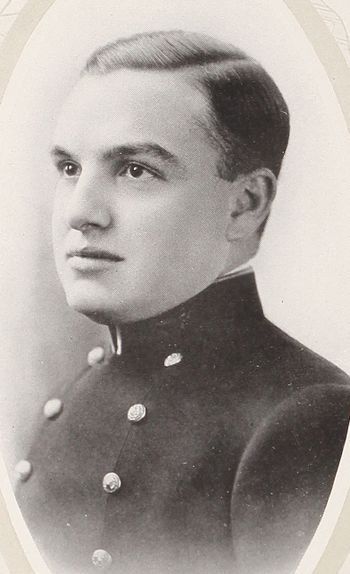WILLIAM S. HACTOR, LCDR, USN
William Hactor '15
Lucky Bag
From the 1915 Lucky Bag:
William Sandwood Hactor
Washington, D.C.
"Bill" "Hac" "Ignatz"
"WHY, certainly!" "Aw, gwan! where—" A noise of books being suddenly and violently closed together with murmurs of "Hey! pipe down!" "Can the gab!" More racket—and a gurgling, happy laugh that causes other faces to broaden out in a quick grin. There goes Hac on another of his endless dissertations, subject immaterial. Do we object? No, indeed, for there never will be a competent successor. It matters not what time of day or night, nor what the cares of the morrow, because Bill is always ready for a session, and he forgets his cares. The only time he is at a loss is in Spanish recitations, where poor Bill can't seem to find two words to put together in a grammatical sequence.
He grafted all Plebe summer as battalion C. P. O.; we'll hand it to him, he was an efficient-looking guy—we never did see him do anything. We all thought he was a pretty mean critter then, but we've changed course 180 degrees since. Ignatz has done more to lower the class standing of the old Eighth than any other factor; he has been ragged visiting a hundred times, and then he was getting away with nine chances out of ten. When not visiting he was helping Freddie kill time in some of the various highly interesting manners which come natural to French.
But don't think that Hac was an unwelcome visitor. There wasn't a man but would rather have Hac in to bull about his experiences for two hours than to bone Calc for a tenth of that time.
"Wait till you see Me, boy!
Class Crest Committee.

William Sandwood Hactor
Washington, D.C.
"Bill" "Hac" "Ignatz"
"WHY, certainly!" "Aw, gwan! where—" A noise of books being suddenly and violently closed together with murmurs of "Hey! pipe down!" "Can the gab!" More racket—and a gurgling, happy laugh that causes other faces to broaden out in a quick grin. There goes Hac on another of his endless dissertations, subject immaterial. Do we object? No, indeed, for there never will be a competent successor. It matters not what time of day or night, nor what the cares of the morrow, because Bill is always ready for a session, and he forgets his cares. The only time he is at a loss is in Spanish recitations, where poor Bill can't seem to find two words to put together in a grammatical sequence.
He grafted all Plebe summer as battalion C. P. O.; we'll hand it to him, he was an efficient-looking guy—we never did see him do anything. We all thought he was a pretty mean critter then, but we've changed course 180 degrees since. Ignatz has done more to lower the class standing of the old Eighth than any other factor; he has been ragged visiting a hundred times, and then he was getting away with nine chances out of ten. When not visiting he was helping Freddie kill time in some of the various highly interesting manners which come natural to French.
But don't think that Hac was an unwelcome visitor. There wasn't a man but would rather have Hac in to bull about his experiences for two hours than to bone Calc for a tenth of that time.
"Wait till you see Me, boy!
Class Crest Committee.
Loss
William was "lost at sea off Laguna Beach [California] piloting flying boat during trip from Seattle to San Diego." One other crewman was lost.
Other Information
From researcher Kathy Franz:
William was an only child who never married. He was born in Fort Robinson, Nebraska, and appointed from Missouri.
On July 2, 1915, William gave testimony about the stolen examination papers for the modern languages examination for the first and second classes. He and 15 others copied the information from H. H. Harrison (’15) who obtained it from Midshipman Leonard P. Wessell (‘17.) Wessell copied it from James E. Moss (non-grad ’17) who had received the information in the mail. William J. Nunnally (’15) was caught with the information during an examination, but commander F. A. Traut said it differed from the test itself. Nunnally testified that he got similar information before every examination, but it varied in quantity and character.
In 1920 William was on the U.S.S. Isherwood. He then entered the naval aviation service and had a total of more than 1,000 flying hours to his credit.
William arrived in Honolulu in late May 1922, and became executive officer of the naval air station.
In October 1922, William and J. M. Farrell were flying seaplane 44 with Governor R. Wallace Farrington on board. The governor was returning from the Maui County fair at Kahului. Seaplane 46 commanded by Commander John Rogers followed.
Per The Honolulu Advertiser, October 15, 1922, Farrington said: “I noticed smoke just off Diamond Head, but paid no attention to it, thinking it was from the engine. As I was occupying the radio operator’s seat in the nose of the plane, I was unable to see the rear of the cockpit without turning around. The smoke increased and I next felt something burn my arm, but took it for granted that it was an electric shock from some of the wiring. The first intimation I had that the plane was afire was when Lieutenant Hactor, in charge of the engines, asked me where the smoke was coming from. A quick inspection showed us the fire in the cockpit, presumably from a short circuit.
“Hactor got out the life preservers, remarking that we might need them. Obeying instructions, I climbed out on the plane, while the two officers attempted to extinguish the flames. They knew exactly what to do and displayed remarkable coolness, but the fire already had gained great headway. We were near Pearl Harbor by this time and had glided down to the surface of the water, while Commander Rodgers’ plane was close behind us. The order was given to ‘abandon ship,’ and we all went overboard and swam to the other seaplane, which picked us up. It was the first time I ever swam with a life preserver on, and I found it quite a help.”
The governor praised the officers of the seaplane for their quick action and skill in handling the situation.
“A great deal of credit is due them,” he declared, “and it was their ability in the face of danger that turned the whole thing into merely an exciting experience.”
A short circuit in the radio apparatus was the cause of the fire. About five minutes after abandoning the plane, the gas tank exploded, and the plane was completely destroyed.
On December 26, 1922 in Honolulu, William was involved in a car accident with Mr. and Mrs. Fred G. W. Cooper. Mrs. Cooper was injured, and they filed suit against William. In a deposition, he said the Coopers were at fault, not him. He was to leave soon for the Philippines. In May 1924, the naval inquiry board held that they were equally responsible, and the case was settled out of court.
In April 1927, William survived a plane crash and being chased by a herd of bulls. Captain Carlos del Preta was piloting the plane that crashed near an irrigation ditch near Jacumba. Spattered with mud, William and Preta jumped to their feet and waved their arms to signal they were all right. Commander Francesco de Pinedo, a famous Italian aviator, in the other plane was circling overhead. Their actions attracted a herd of 36 bulls which lowered their heads and charged. The two men ran for the barbed-wire fence adjoining the highway and without pausing cleared the fence. As Preta landed in a muddle puddle, William flopped down beside him. The men were then flown by Navy plane to San Diego where De Pinedo sent in his report to Commander Mussolini.
On the day of his final flight, his Boeing torpedo plane left Crescent City for San Diego at 1:15 p.m., and encountered fog off Laguna Beach about 8:30 p.m. Lieutenant Thomas Fisher '18 dropped to a low altitude hoping to fly under it. However, the plane struck the water’s surface, and the two pontoons came off. All three men clung to one pontoon until it sank five minutes later. They were all swimming for shore when about 10:30 p.m.,; Thomas didn’t hear the other two anymore. Thomas reached the shore after nine hours. Chief Machinist Mate Charles Robbins’ body was found the next day at Newport Beach. William’s body washed ashore four days later at Sunset Beach. His body was identified by Lieutenant Ralph Wyman (Class of 1917.)
His father John was a quartermaster sergeant in the Army who had served in Fort Supply, Indian Territory, now western Oklahoma (1890-1895), and at Fort Robinson, Nebraska (1895-1898.) He retired after 30 years in 1908, and at his death in 1911, he was military storekeeper for the state of Virginia. His mother Katharine died in 1919.
William is buried in Arlington National Cemetery.
Related Articles
Thomas Fisher '18 was also aboard when this aircraft crashed, though he was able to swim to shore and survived.
The "Register of Commissioned and Warrant Officers of the United States Navy and Marine Corps" was published annually from 1815 through at least the 1970s; it provided rank, command or station, and occasionally billet until the beginning of World War II when command/station was no longer included. Scanned copies were reviewed and data entered from the mid-1840s through 1922, when more-frequent Navy Directories were available.
The Navy Directory was a publication that provided information on the command, billet, and rank of every active and retired naval officer. Single editions have been found online from January 1915 and March 1918, and then from three to six editions per year from 1923 through 1940; the final edition is from April 1941.
The entries in both series of documents are sometimes cryptic and confusing. They are often inconsistent, even within an edition, with the name of commands; this is especially true for aviation squadrons in the 1920s and early 1930s.
Alumni listed at the same command may or may not have had significant interactions; they could have shared a stateroom or workspace, stood many hours of watch together… or, especially at the larger commands, they might not have known each other at all. The information provides the opportunity to draw connections that are otherwise invisible, though, and gives a fuller view of the professional experiences of these alumni in Memorial Hall.
January 1915
January 1916
January 1917
March 1918
January 1919
January 1920
January 1921
January 1922
May 1923
July 1923
September 1923
November 1923
March 1924
May 1924
July 1924
September 1924
November 1924
January 1925
March 1925
May 1925
July 1925
October 1925
January 1926
October 1926
January 1927
April 1927

The "category" links below lead to lists of related Honorees; use them to explore further the service and sacrifice of alumni in Memorial Hall.